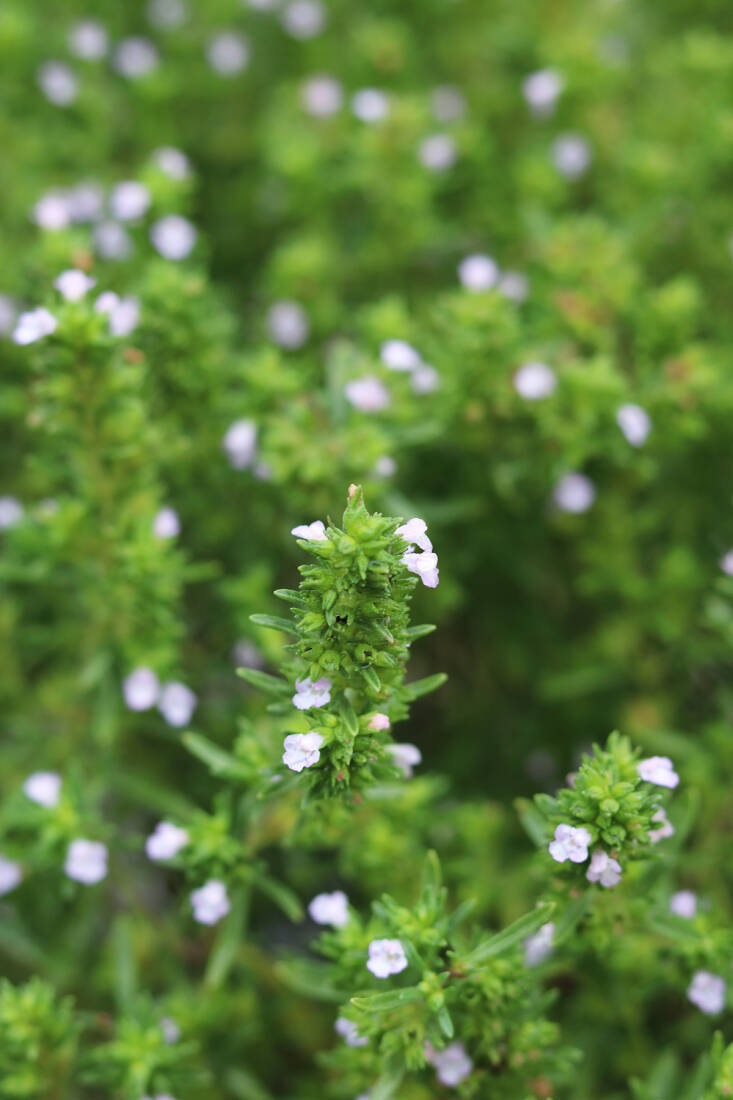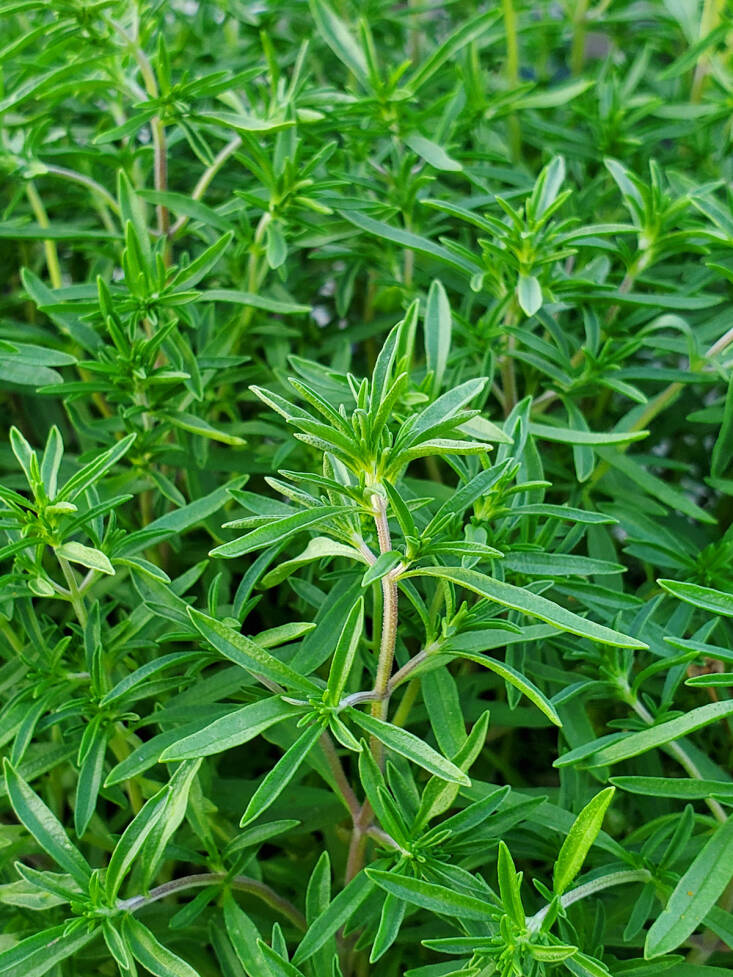In August the summer savory blooming in my window boxes is very popular. Bees are besotted with its tiny white flowers, and I love to cook with the powerful little herb. Mostly, we share. But in late summer I deprive the bees and cut all the wiry stalks to dry their leaves for a different season of meals. Evenings are longer, and it has become possible to imagine autumn, and a time of comforting slow stews, sauces, and casseroles that summer savory will flavor. Meanwhile, the pungent Mediterranean herb has been making everything summery taste extra-good, from grilled peaches to tomato salads and marinated cheese.
Because it is rarely (if ever) sold fresh, summer savory is an herb to grow.
Photography by Marie Viljoen.

Summer savory is the sariette of France and an essential ingredient in the herbes de Provence blend. Hungarians like it (they call it borsik). Sharena sol, a mix of salt, herbs, and paprika, is a table condiment in Bulgaria—chubritsa (summer savory) is prescribed. Germans enjoy summer savory with beans (it is Bohnenkraut—bean herb). It is often the basis of regional Middle Eastern za’atar spice mixes. And it is essential to the Acadian culinary tradition of Canada’s Atlantic coast, where it is required in dishes like fricot (a stew made with potatoes and chicken, fish, or rabbit), and for poultry dressing, especially at Thanksgiving. A Canadian friend describes it as “the aroma awaiting after a winter afternoon of snowshoeing.”

For many American gardeners and cooks this flavorful annual herb—tasting a little like a cross between thyme and oregano, with flashes of bee balm—is still unfamiliar, or is confused with its perennial cousin, winter savory, Satureja montana. Yet its strong, bright aroma seems to improve anything it touches. The herb I dry in summer is the one I use most often in winter.

Stateside, I have never seen summer savory sold as a cut herb, and the seedlings can be hard to find at nurseries. Luckily, it is easily grown from seed. (A packet of summer savory from Botanical Interests is $1.99.) And that seed is just as easily saved, since it produces copious quantities, for such a petite plant. Sow summer savory in late spring in full sun, either in-ground, or in pots or window boxes.

Depending on their soil-depth, summer savory will reach from 6 to 16 inches in height. Plan on growing at least 10 plants if you’d like to dry it for winter use. Pinch back the leaves on young seedlings to encourage the savory to bush out and be more productive.

As summer progresses the plants’ edible stems become woodier, and more wiry. This is the time to cut them for drying.
To preserve the herb for winter and to save seed, cut the branches and spread them across parchment to dry (if they hang in bunches the tiny seeds will drop out). When dry, crush them to release the brittle leaves from the stems. The dry leaves and seeds will keep well in a mason jar through the winter. (You’ll notice the tiny black seeds dropping out into the jar – store them in an envelope until the following late spring.)

The most tender leaves and stems are wonderful as a chopped, fresh rub, tossed onto mushrooms, or over peaches that you grill on cooling coals. It’s a quick stuffing under the skin of a chicken or chicken pieces, and complements dark fish like mackerel and blue fish. The dried herb is essential in my winter paprikash, and in slow-cooked cassoulets, bean bowls, and lentil stews.





Warm Tomato and Summer Savory with Yogurt
Serves 2
I learned about the pleasures of warm yogurt from a Turkish friend, long ago. Its addition makes this quick, seasonal meal deceptively filling.
- 2 Tablespoons extra virgin olive oil
- 1 Tablespoon butter
- 1 clove of garlic, sliced
- 2 small heirloom tomatoes, sliced
- 1 cup Greek yogurt
- 1/8 teaspoon salt
- Freshly-ground black pepper
- 1 teaspoon fresh summer savory
In a skillet over medium heat warm the olive oil and butter. Add the garlic and cook until it begins to smell good – about 2 minutes. Layer the tomato slices in the skillet, leaving one side open for the yogurt-to-come. Cook long enough for their bottoms to begin sizzling. Add the scoop of yogurt and reduce the heat to medium-low. Cook to warm the yogurt through, about 3 minutes. Season with salt and black pepper to taste. Scatter the savory across just before serving. Eat with a spoon!
For more unusual spices and herbs to grow, see:
- Sand Ginger: An Unusual Herb to Grow and Eat at Home
- Prickly Ash and Spicebush: Native Shrubs for your Spice Collection
- Spice Kit: How to Grow Ginger, Turmeric, and Cardamom at Home












Have a Question or Comment About This Post?
Join the conversation (0)